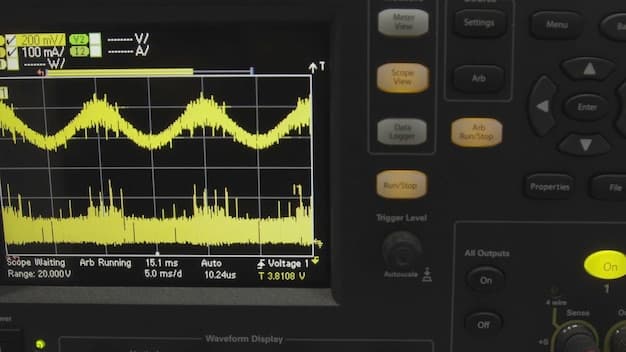The Ultimate Guide to Launching a Profitable Podcast Side Hustle in 2025

Starting a profitable podcast as a side hustle in 2025 requires careful planning, the right equipment, compelling content, and consistent promotion to attract listeners and generate revenue through various monetization strategies.
Want to turn your passion into profit? In 2025, launching a podcast is a fantastic side hustle. This ultimate guide to starting a profitable podcast as a side hustle in 2025 (practical solutions) will walk you through every step.
Why Start a Podcast as a Side Hustle in 2025?
Podcasting is booming, offering a unique opportunity to connect with a global audience. But why should you consider starting a podcast as a side hustle specifically in 2025?
The podcasting landscape is maturing, meaning there are established pathways to monetization and audience growth. But it’s also still dynamic enough that new, innovative voices can break through.
Low Barrier to Entry
Compared to other online ventures, podcasting has relatively low start-up costs. You don’t need fancy equipment to get started, and there are numerous free and affordable resources available.
Flexibility and Control
Podcasting offers unparalleled flexibility. You can record episodes on your own time, from anywhere in the world. Plus, you have complete control over your content, format, and brand.
Multiple Revenue Streams
Once you’ve built an audience, you can monetize your podcast through various avenues, including:
- Advertising: Earn money by running ads during your episodes.
- Affiliate Marketing: Promote products or services and earn a commission on sales.
- Sponsorships: Partner with brands for sponsored segments or entire episodes.
- Premium Content: Offer exclusive content, bonus episodes, or ad-free listening for paying subscribers.
Podcasting creates a intimate connection with your audience. It’s a way to share your thoughts, ideas, and expertise with like-minded individuals around the globe. In 2025 its also growing as marketing tool for businesses to help promote their products and services.

Essential Equipment and Software for Podcasting
While you don’t need to break the bank, investing in some essential equipment and software will significantly improve your podcast’s audio quality and production value.
Think of this area of the podcast as needing the tools necessary to be effective. With out the proper software or equipment the podcast might not be as effective for the listener.
Microphone
A high-quality microphone is arguably the most crucial piece of equipment. Consider a USB microphone for simplicity or an XLR microphone for more professional setups.
Headphones
Headphones are essential for monitoring your audio while recording and editing. Closed-back headphones are ideal for preventing sound leakage.
Recording and Editing Software (DAW)
A Digital Audio Workstation (DAW) is software used for recording, editing, and mixing audio. Popular options include:
- Audacity: A free, open-source DAW that’s perfect for beginners.
- GarageBand: A free DAW included with macOS.
- Adobe Audition: A professional-grade DAW with advanced features (paid subscription).
- Descript: A user-friendly DAW that combines audio and video editing with transcription capabilities.
Optional Accessories
Other helpful accessories include a pop filter (to reduce plosives), a microphone stand (for stable positioning), and acoustic treatment (to minimize echo and reverb).
Having the correct equipment creates a better overall process for the person that is recording it. In turn the finished product is better and more audibly appealing to the listener.

Defining Your Podcast Niche and Target Audience
Before you start recording, it’s crucial to define your podcast’s niche and identify your target audience.
Choosing a specific audience and niche increases the likely hood of people listening in frequently and becoming a regular part of your audience.
Choose a Niche You’re Passionate About
Your passion will shine through in your podcast, making it more engaging for listeners. Plus, you’ll be more motivated to create consistent content.
Research Your Target Audience
Understand their interests, needs, and pain points. This will help you tailor your content to resonate with them.
Analyze the Competition
Identify other podcasts in your niche. What are they doing well? Where can you differentiate yourself?
Test Your Ideas
Before fully committing, test your ideas by creating sample episodes or conducting audience surveys.
By thoroughly understanding and researching your audience you allow yourself the opportunity to grow the podcast and possibly even turn it into a full time endeavor. This also gives you options later to expand.
Creating Compelling Podcast Content
High-quality content is the heart of any successful podcast. Here’s how to create episodes that keep listeners coming back for more.
Content is the most important thing for a podcast. If the content is not interesting or entertaining the listener is more than likely not going to listen.
Develop a Consistent Format
Choose a format that suits your content and target audience. Options include interviews, solo shows, panel discussions, and narrative storytelling.
Plan Each Episode
Create an outline or script to ensure your episodes are focused and engaging. This doesn’t mean you have to read verbatim, but it helps to have a roadmap.
Tell Stories
Stories are powerful tools for connecting with listeners on an emotional level. Use personal anecdotes, case studies, or fictional narratives to illustrate your points.
Engage With Your Listeners
Encourage feedback, answer questions, and create a sense of community. Consider incorporating listener mailbag segments or social media polls.
Compelling podcast content can set you apart from others. Listeners will be engaged and more readily available to listen frequently. Creating great content can turn the hustle into something full time.
Growing Your Podcast Audience in 2025
Creating a great podcast is only half the battle. You also need to actively promote it to attract listeners and build a loyal audience. These strategies are sure to grow your audience.
Growing your podcast in a technological world is not going to be an easy task. Staying ahead of new technology will give you the edge.
Optimize for Search Engines (SEO)
Use relevant keywords in your podcast title, episode titles, and descriptions. This will help people find your podcast on search engines like Google and podcast directories.
Leverage Social Media
Promote your podcast on social media platforms like Twitter, Facebook, Instagram, and LinkedIn. Share snippets, behind-the-scenes content, and engage with your followers.
A Digital Audio Workstation (DAW) is software used for recording, editing, and mixing audio. Popular options include: Social media helps to create a rapport with listeners which grows your engagement. Engaging in socials can make a difference.
Guest Appearances
Be a guest on other podcasts in your niche to reach new audiences. Similarly, invite guests to your podcast to tap into their existing followers.
Email Marketing
Build an email list and send out regular newsletters with episode updates, behind-the-scenes content, and exclusive offers. This is a direct line to your most loyal fans.
Growing your audience will allow more opportunity to turn engagement into monitization and revenue. Use every opportunity to grow and engage with your audience on all platforms.
Monetizing Your Podcast: Practical Solutions
Once you’ve built a solid audience, it’s time to start thinking about monetization. There are several ways to generate revenue from your podcast.
Turning your podcast from a hobby into a business will need to be something that you take seriously. Monetizing your podcast requires the same amount of effort as anything else.
Advertising and Sponsorships
Sell ad slots or sponsorships to brands that align with your podcast’s content and audience. You can charge per episode or offer package deals.
Affiliate Marketing
Promote products or services that you believe in and earn a commission on sales generated through your unique affiliate links.
Premium Content
Offer bonus episodes, ad-free listening, or early access to content for paying subscribers. Platforms like Patreon and Memberful make it easy to manage subscriptions.
Selling Merchandise
Create branded merchandise, such as t-shirts, mugs, or stickers, and sell them to your listeners. This is a great way to build brand awareness and generate additional revenue.
Finding the correct monetization options is a process that can be tailored to the needs of the podcast, its listeners, and a brands services. Getting creative can help to grow the opportunities.
Analyzing Your Podcast Performance and Adapting
Regularly analyzing your podcast’s performance is essential for understanding what’s working and what’s not. Use data to inform your decisions and adapt your strategy accordingly.
Data is the driving line for performance. Without data you don’t know what is working or what is not. So stay on top of the data, it will speak volumes.
Track Key Metrics
Monitor metrics such as downloads, listens, audience demographics, and engagement on social media. These insights will help you understand your audience and optimize your content.
Gather Listener Feedback
Ask listeners for feedback through surveys, polls, or email. This will provide valuable qualitative data to complement your quantitative metrics.
- Audience Engagement: Are listeners actively participating in discussions?
- Content Relevance: Is your content meeting their needs and expectations?
- Overall Experience: Are they enjoying the podcast and finding it valuable?
A/B Test Different Strategies
Experiment with different episode formats, promotion tactics, and monetization strategies to see what works best for your podcast.
Adapting throughout the creation and growth of you podcast is incredibly important. Take the time to dive into the analytics and make necessary adjustments. Use the data to your advantage.
| Key Point | Brief Description |
|---|---|
| 🎧 Niche Selection | Choose a passionate niche and tailor to audience interests. |
| 🎤 Essential Equipment | Invest in a quality microphone, headphones, and DAW software. |
| 📈 Audience Growth | Utilize SEO, social media, guest appearances, and email marketing. |
| 💰 Monetization | Explore ads, affiliates, premium content, and merchandise for revenue. |
Frequently Asked Questions
▼
You’ll need a microphone, headphones, and recording and editing software (DAW). A pop filter and microphone stand are helpful additions. Focus on sound first.
▼
Choose a niche you’re passionate about and that has a defined target audience. Research the competition and look for opportunities to differentiate yourself. Don’t be afraid to test an idea.
▼
Consistency is key. Aim for a regular schedule, such as weekly or bi-weekly episodes. Set the expectation for the listener base to continue coming back. Be transparent if something comes up.
▼
Utilize SEO, social media, guest appearances, and email marketing. Engage with your audience and build a community. Consistency is key to growing your audience.
▼
Explore advertising, affiliate marketing, premium content, and selling merchandise. Choose monetization strategies that align with your podcast’s content and audience, test and evaluate.
Conclusion
Starting a profitable podcast as a side hustle in 2025 requires careful planning, consistent effort, and a willingness to adapt. By following this ultimate guide, you’ll be well-equipped to launch a successful podcast and turn your passion into profit. Enjoy growing and building the business.





